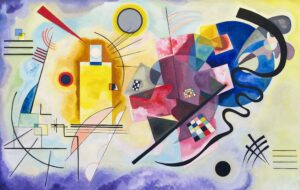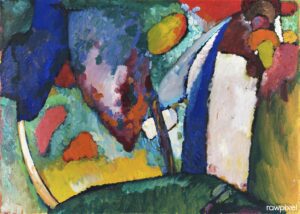Der Blaue Reiter is a seminal movement in art that reshaped the landscape of expression and abstraction.
We’ll explore the vibrant rebellion against traditional aesthetics that propelled artists like Kandinsky and Marc to the forefront of avant – garde art.
This movement wasn’t just a style; it was a spiritual quest for authenticity and depth in artistic expression.
Join us as we jump into the colorful world of Der Blaue Reiter and its lasting impact on modern art.
Origins Of Der Blaue Reiter
The emergence of Der Blaue Reiter can be traced back to the early 20th century, rooted deeply in a period of rapid modernization and cultural shifts.
Our research takes us to Munich, where the movement’s inception coincided with a turbulent era in art where rules were being questioned and a thirst for innovation bubbled beneath the surface.
Wassily Kandinsky and Franz Marc, both pivotal figures in the formation of Der Blaue Reiter, shared a frustration with the restrictive traditions of representational art.
They envisioned a form of expression that transcended the visual; where color and form were not bound strictly to the physical world but were vehicles for spiritual and emotional communication.
- Relationships and collaborations among artists,
- Joint exhibitions that defied conventional norms,
- Manifestos and writings that outlined their artistic vision.
It wasn’t just a single event that sparked the advent of Der Blaue Reiter but a series of encounters and exchanges.
One of the pivotal moments was the rejection of Kandinsky’s painting Composition V from an exhibition by the New Artists’ Association – an event that pushed Kandinsky, Marc, and others toward establishing their own group.
Their inaugural exhibition in 1911 didn’t just showcase a new style of painting; it displayed an anthology of artistic rebellion.
The exhibit included an eclectic mix of artworks, from medieval and folk art to children’s drawings, emphasizing a universal language of art that transcended time and culture.
The movement was less about a homogenous style but rather a shared philosophy – a commitment to exploring the profound depths of art’s potential.
For us, this sets the stage for understanding the multifaceted nature of Der Blaue Reiter.
Our exploration continues as we jump deeper into the methods and mediums these avant-garde artists employed to convey their groundbreaking ideas.

Key Artists Of The Movement
Wassily Kandinsky’s progression from figurative painting to abstract compositions makes him a central figure in Der Blaue Reiter.
His works like Composition VII and On White II are seminal in the abstraction movement, where colors and shapes assume the power of expression.
Franz Marc, known for his vivid use of color in depicting animals, saw them as symbols of a purer world.
His paintings, such as The Tower of Blue Horses and Yellow Cow, reflect a search for spiritual truth through nature, a vital element of the movement’s philosophy.
At the crux of the Der Blaue Reiter were several other influential artists:
- August Macke – who blended his love for bright colors with inspiration from French Impressionism and Fauvism,
- Alexej von Jawlensky – whose portraiture and abstract forms echoed an internal, emotional landscape,
- Paul Klee – whose playful, child-like imagery provided a whimsical yet profound depth to the group’s collective work.
Gabriele Münter was instrumental not only as Kandinsky’s partner but also for her landscapes and portraits that encapsulated the spirit of the movement.
Landscape with Tower is a testament to her bold use of color and form.
These artists, often collaborating and always innovating, forged paths for future generations to explore.
By pushing beyond the limits of the canvas and the paint, they invited viewers into a more expansive and immersive world.
From filmmaking to digital art, the legacy of these creative visionaries is evident as they influence diverse fields and challenge creators to envision beyond the traditional boundaries.
The Philosophical Foundations
The Der Blaue Reiter movement wasn’t just a shift in artistic style; it was a profound jump into the realm of abstract thinking.
Our examination of this movement reveals philosophical underpinnings that were as significant as the vibrant canvases the artists produced.
These thinkers were influenced by a wave of ideas that included theosophy and anthroposophy.
Artists like Wassily Kandinsky and Franz Marc were on a quest for a more profound spiritual truth through art.
They believed that color and form were the keys to unlocking the emotions and spirit of the viewer, far beyond what representational art could achieve.
It’s the abstraction in their work that strips away the distractions of the subject, focusing solely on these elements to evoke contemplation and existential reflection.
Influences And Inspirations
We can’t overlook the various influences that shaped the philosophies of Der Blaue Reiter artists:
- The writings of Friedrich Nietzsche and his ideas on the Übermensch and individualism,
- Rudolf Steiner’s concepts of spiritual science and the development of the inner self,
- The fascination with Russian folklore and native art forms that emphasized spirituality over realism.
These diverse inspirations fused together within the movement, each artist interpreting them in their unique way.
Our journey through Der Blaue Reiter’s philosophical grounds helps us understand why their art feels so timeless and mesmerizing – it’s not just art for art’s sake; it’s a window to a multidimensional universe they believed we’re all a part of.
The Manifesto Of Der Blaue Reiter
The publication of The Blue Rider Almanac introduced groundbreaking ideas that would shape modern art forever.
Edited by Wassily Kandinsky and Franz Marc, the Almanac served as the manifesto for Der Blaue Reiter – encapsulating the revolutionary ideas of spiritual and emotional expression through art.

The manifesto delved into the importance of the inner need of the artist and the spiritual resonance of colors and forms.
Diverse in its content, The Blue Rider Almanac featured essays, illustrations, and musical scores that articulated the group’s philosophy.
The inclusion of children’s drawings, primitive art forms, and non-Western art showcases the artists’ belief in the universal visual language that exists beyond the traditional Western canon.
They emphasized art’s potential to connect deeply with the viewer, urging a move away from mere representation.
Within its pages, The Blue Rider Almanac also addressed the group’s ethos:
- Artistic Synthesis – Integrating varied art forms like painting, music, and theatre,
- Utopian Ideals – Envisioning a future where art contributes to spiritual awakening and unity,
- Innovation – Championing new approaches to color and composition.
Our understanding of the Der Blaue Reiter movement is enriched by exploring these distinct perspectives and intentions.
The manifesto documented a pivotal moment in art history where boundaries were blurred and the scope of artistic influence was expanded dramatically.
It’s a testament to a time when art was considered a vehicle for much deeper, universal communication, and the Almanac encapsulated that enduring vision.
The Influence And Legacy
Der Blaue Reiter’s impact stretches far beyond its initial exhibitions and the lifespan of its core members.
We recognize the movement’s influence in various creative fields, from painting to filmmaking.
It’s pivotal in the evolution of modern art:
- Artists adopted bold experiments with color and form,
- There was a shift toward abstraction, influencing later movements like Expressionism and Surrealism,
- Non-representational art gained momentum.
The ethos of Der Blaue Reiter resonated strongly with future generations of artists.
We see the legacy of their unbounded innovation in:

- The avant-garde cinema of the 1920s and beyond,
- Abstract expressionist painters like Jackson Pollock and Mark Rothko,
- Contemporary art installations that prioritize sensory experience over realism.
Our understanding of art as a medium that transcends cultural barriers and speaks to universal human emotions owes much to groups like Der Blaue Reiter.
Even today, their approach informs our storytelling methods in film, the frame compositions, and color palettes we choose to evoke specific feelings in an audience.
Educational institutions continue to study the movement, ensuring that the principles and innovations of Der Blaue Reiter inform current artistic practices.
We find curricula designed around their philosophies and techniques:
- Analysis of the use of color to convey emotion,
- Exploration of non-traditional materials and forms,
- Emphasis on spiritual and existential themes through art.
Their influence is also palpable in the commercial art world – from gallery exhibitions showcasing their original works to modern marketing campaigns that employ their strategies for visual engagement.
Art collectors and enthusiasts still seek out Der Blaue Reiter pieces, confirming the enduring appeal and significance of the movement.
What Is Der Blaue Reiter In Art – Wrap Up
We’ve explored the profound impact Der Blaue Reiter has had on the art world, from its inception to its enduring legacy.

By challenging the status quo and fostering a space for artistic freedom, this movement has left an indelible mark on the canvas of history.
It’s clear that the reverberations of these pioneering artists’ bold strokes are still felt today, as their vision continues to inspire and shape the future of creative expression across the globe.
Their commitment to transcending the traditional has not only redefined the boundaries of art but also enriched our cultural heritage.
As we reflect on their achievements, we’re reminded of the power of collaboration, innovation, and the unyielding pursuit of artistic evolution.
Frequently Asked Questions
What Was The Der Blaue Reiter Movement?
The Der Blaue Reiter was an avant-garde art movement that formed in early 20th-century Munich.
It focused on using color and form to express spiritual and emotional meanings beyond the visual appearances.
Who Were The Key Artists Involved In The Der Blaue Reiter Movement?
Key artists included Wassily Kandinsky, Franz Marc, August Macke, Alexej von Jawlensky, Paul Klee, and Gabriele Münter.
These individuals were fundamental in shaping the movement’s philosophical and aesthetic directions.
Why Was Der Blaue Reiter Formed?
The movement was formed as a response to the rejection of Wassily Kandinsky’s Composition V from an exhibition by the New Artists’ Association.
It sought to create a platform for artistic freedom and innovation, diverging from conventional norms.
What Was The Impact Of Der Blaue Reiter On The World Of Art?
Der Blaue Reiter significantly influenced the shift towards abstraction in art.
It also helped inspire various creative fields, including avant-garde cinema, abstract expressionism, contemporary art, and storytelling in film.
How Does Der Blaue Reiter Influence Contemporary Art Today?
Educational institutions still study the movement, and its principles continue to inform current artistic practices.
In the commercial art world, works from the movement are highly valued and frequently exhibited, maintaining a lasting appeal.


